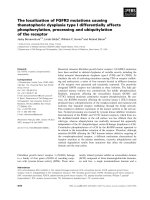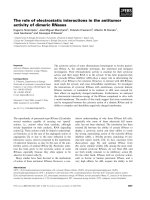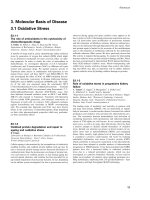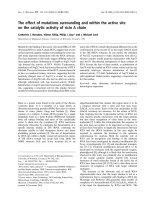Báo cáo khoa học: The propagation of hamster-adapted scrapie PrPSc can be enhanced by reduced pyridine nucleotide in vitro pdf
Bạn đang xem bản rút gọn của tài liệu. Xem và tải ngay bản đầy đủ của tài liệu tại đây (449.95 KB, 10 trang )
The propagation of hamster-adapted scrapie PrP
Sc
can be
enhanced by reduced pyridine nucleotide in vitro
Song Shi, Chen-Fang Dong, Chan Tian, Rui-Min Zhou, Kun Xu, Bao-Yun Zhang, Chen Gao,
Jun Han and Xiao-Ping Dong
State Key Laboratory for Infectious Disease Prevention and Control, National Institute for Viral Disease Control and Prevention, Beijing, China
Transmissible spongiform encephalopathies (TSEs),
also known as prion diseases, are lethal neurodegener-
ative diseases, including Creutzfeldt–Jakob disease,
Gerstmann–Straussler–Scheinker syndrome and fatal
familial insomnia in humans, bovine spongiform
encephalopathy in cattle, scrapie in sheep and goats,
and chronic wasting disease in deer and elk [1,2]. TSEs
are caused by a proteinaceous infectious agent, termed
a prion, which is considered to consist of a misfolded
and aggregated protease-resistant isomer of a host-
encoded glycoprotein (PrP
C
) [3,4]. The pathological
isomer present in the tissues of infected individuals is
called PrP
Sc
. Although the clinical and pathological
characteristics of TSEs have been recognized for a long
time, the mechanisms underlying prion conversion are
only partially settled.
Recently, some endogenous factors encoded by
prion hosts have been proposed as essential during the
propagation of prions in studies in animal models and
cell-culture systems, i.e. protein X and some chaperons
[5–10]. Polyanions and sulfated glycans are also
thought to be involved in converting PrP
C
into the
abnormal isomer in vitro [11–14]. Moreover, pyridine
nucleotides, a group of coenzymes ubiquitous in bio-
synthesis and metabolism, are associated with the
aggregation of recombinant prion protein (rPrP).
Following incubation with reduced pyridine nucleo-
tides, e.g. NADPH, rPrP can accumulate in fibrils and
acquire weak proteinase resistance [15,16]. Several
studies have shown that the amount of NADPH-
diaphorase increases during the early stage of prion
disease [17], but there is no direct molecular evidence
Keywords
PMCA; prion; propagation; pyridine
nucleotide; transmissible spongiform
encephalopathies
Correspondence
X P. Dong, State Key Laboratory for
Infectious Disease Prevention and Control,
National Institute for Viral Disease Control
and Prevention, Chinese Center for Disease
Control and Prevention, Ying-Xin Rd 100,
Beijing 100052, China
Fax: +86 10 63532053
Tel: +86 10 83534616
E-mail:
(Received 16 September 2008, revised 15
November 2008, accepted 22 December
2008)
doi:10.1111/j.1742-4658.2009.06871.x
Transmissible spongiform encephalopathies (TSEs), or prion diseases, are
fatal neurodegenerative disorders caused by an infectious agent termed a
prion, which can convert normal cellular prion protein (PrP
C
) into a patho-
logically misfolded isoform (PrP
Sc
). Taking advantage of protein misfolding
cyclic amplification (PMCA), a series of experiments was conducted to
investigate the possible influences of pyridine nucleotides on the propaga-
tion activities of hamster-adapted scrapie agents 263K and 139A in vitro
using normal hamster brain homogenates and recombinant hamster PrP as
the substrates. The results showed that PrP
Sc
from both scrapie agent
263K- and 139A-infected brains propagated more efficiently in PMCA with
the addition of reduced NADPH, showing an obvious dose-dependent
enhancement. Reduced NADH also prompted PrP
Sc
propagation, whereas
NADP, NAD and vitamin C failed. Moreover, following incubation with
NADPH, recombinant hamster PrP could be efficiently converted into the
proteinase K-resistant form when exposed to the trace of PrP
Sc
from
infected hamsters. Our data provide evidence that the reduced pyridine
nucleotide plays an important role in the propagation of prion and this
process seems to target PrP
C
molecules.
Abbreviations
NBH, normal brain homogenate; PK, proteinase K; PMCA, protein misfolding cyclic amplification; rPrP, recombinant PrP; ScBH, scrapie-
infected brain homogenate; SHa, Syrian hamster; TSEs, transmissible spongiform encephalopathies.
1536 FEBS Journal 276 (2009) 1536–1545 ª 2009 The Authors Journal compilation ª 2009 FEBS
to clarify the mechanism by which reduced pyridine
nucleotides affect PrP molecules.
A novel technology, named protein misfolding cyclic
amplification (PMCA) has been described in recent
years [18], providing an efficacious, unique and conve-
nient experimental approach to evaluating the replica-
tion and infectivity of newly formed PrP
Sc
in vitro [19].
Following incubation of PrP
Sc
from TSE-infected ani-
mals with homologous PrP
C
from normal brains, large
quantities of PrP
Sc
can be achieved after a short cycle of
alternate sonication and incubation [20,21]. This tech-
nology is considered the most appropriate approach to
understanding the fundamental mechanisms involved in
PrP
Sc
propagation, aggregation and neuroinvasion
in vivo [22]. In this study, possible influences of pyridine
nucleotides on the propagation of PrP
Sc
from scrapie-
infected hamsters in PMCA were investigated. We
found that reduced pyridine nucleotide NADPH pro-
moted PrP
Sc
-propagating activity in PMCA using PrP
C
from normal hamster brains as the substrate, and that
this was a dose-dependent response. Other reduced ana-
logues of pyridine nucleotides also showed enhanced
capacity, whereas an oxidized analogue failed. Further-
more, we proposed that after incubation with NADPH,
recombinant hamster PrP could be converted to the
proteinase K (PK)-resistant isoform in the presence of
scrapie PrP
Sc
in PMCA.
Results
The propagating activities of PrP
Sc
in PMCA are
remarkably enhanced in the presence of NADPH
To see the influence of NADPH on the ability of PrP
Sc
to propagate in PMCA, a serial PMCA protocol con-
sisting of seven rounds was conduced (Fig. 1A). Prior
to mixing with a 10
)2
dilution of ScBH prepared from
scrapie 263K-infected hamsters (SHa-263K), hamster
NBH was mixed with 10 lm NADPH (referred as
NBH + NADPH, lanes 3–9) and subjected to 12
PMCA cycles. Thereafter, 10 lL of PMCA product
was added to 90 lL of fresh NBH with 10 lm
NADPH and the next round was performed. This was
repeated several times, leading to the original ScBH
being diluted to 10
)8
. Meanwhile, mixture containing
only NADPH and ScBH in the conversion buffer, but
without NBH (referred as NADPH control, lanes 3–9),
or one containing NBH and ScBH but without
NADPH (referred as NBH control, lanes 3–9), was
prepared as above. Each PMCA product was digested
with PK and subjected to western blotting. PK-resis-
tant PrP signal was detected only in the first NADPH
control preparation (upper gel), representing the initial
input PrP
Sc
(Fig. 1A, lane 2 in all gels). In the NBH
control, the PrP
Sc
signal was strongest during round 1,
weakened gradually and vanished from round 4 (mid-
dle gel), indicating lower PMCA-propagating activity
under these conditions. By contrast, in the presence of
NADPH, obvious PrP
Sc
signals were seen in all prepa-
rations from round 1 to round 7 (Fig. 1A, lower gel),
highlighting a more actively propagating capacity for
PrP
Sc
. This suggests that NADPH can prompt the
propagation of scrapie agent 263K. In addition, no sig-
nificant propagation of PrP
Sc
was observed in seeded
preparations without sonication (Fig. S1A) or in
PMCA samples without seeding ScBH (Fig. S1B),
Fig. 1. NADPH induced more efficient propagation of PrP
Sc
from
scrapie agents in PMCA. Ten microliters of a 100-fold dilution of
ScBH of SHa-263K or SHa-139A were used as the seed in each prep-
aration. PMCA was conducted over 12 cycles per round, with seven
rounds in total. (A) Propagation of PrP
Sc
from hamster-adapted scra-
pie agent 263K in PMCA. The NADPH control (upper gel) contained
10 l
M NADPH in conversion buffer and ScBH, but without NBH. The
NBH control (middle gel) contained NBH and ScBH, but without
NADPH. NBH plus NADPH (lower gel) contained NBH, ScBH and
NADPH. (B) Propagations seeded with hamster-adapted scrapie
agent 139A underwent the same PMCA procedure containing NBH
alone (upper gel) or NBH plus NADPH (lower gel). In all gels, NBH
was loaded directly in the first lane without proteolysis as a refer-
ence for comparison of electrophoretic mobility (PrP
C
PK)). All other
samples were treated with 50 lgÆmL
)1
PK (PK+). 0 indicates reac-
tions containing ScBH before PMCA process. Round numbers are
given on top. The molecular markers are indicated on the right.
S. Shi et al. NADPH can enhances PrP
Sc
propagation
FEBS Journal 276 (2009) 1536–1545 ª 2009 The Authors Journal compilation ª 2009 FEBS 1537
implying that NADPH can neither enhance PrP
Sc
propagation without PMCA nor induce spontaneous
conversion of PrP
C
into PrP
Sc
with PMCA in vitro.
To test whether NADPH-related enhancement was
also appropriate to another scrapie agent, hamster-
adapted scrapie strain 139A (SHa-139A) was used in
PMCA following the same procedure. In order to
avoid possible environmental contamination, all mate-
rials and reagents were freshly prepared, including the
homogenizer, chemicals and conversion buffer. NBH
and ScBH (SHa-139A) were prepared in another labo-
ratory that had never been exposed to prions. Like
SHa-263K, PK-resistant signals were detected in reac-
tions from round 1 to round 7 in the presence of
NADPH (Fig. 1B, lower), but only in the first three
rounds without NADPH (Fig. 1B, upper). These
results indicate that propagation of SHa-139A in vitro
can also be prompted by NADPH, and therefore this
enhancement of PrP
Sc
propagation in PMCA is not
limited to only one prion strain.
NADPH increased the sensitivity for detection of
PrP
Sc
in brain homogenates by PMCA
To test the potential of using NADPH as an assistant
chemical in increasing the detection sensitivity of
PMCA, comparative analysis of serial PMCA, with or
without NADPH, was conducted using serially diluted
ScBH from agent 263K as the seed. Dilutions of the
original ScBH ranged from 10
)4
to 10
)12
by 100-fold
serial dilution. One round of PMCA consisted of 24
cycles (24 h), which was considered to be more effi-
cient at increasing PrP
Sc
aggregation [19] and allowed
low levels of PrP
Sc
to be detected [23]. After one round
of PMCA, 10 lL of product was mixed with 90 lLof
fresh NBH for the next round, up to seven rounds.
Figure 2 shows that PrP
Sc
signals were detected at
dilutions of 10
)6
and 10
)8
in the second round in the
presence of 10 lm NADPH (second gel, lanes 2 and
3), whereas PrP
Sc
signals could be observed at a dilu-
tion of 10
)6
in the third round (third gel, lane 7) and
10
)8
in the fifth round (fifth gel, lane 8) in the absence
of NADPH. After seven rounds of PMCA, clear PrP
Sc
signals were observed at ScBH dilutions of 10
)4
to
10
)10
, and even at a 10
)12
-fold dilution a weak band
was observed in the presence of NADPH (lower gel,
lane 5). However, no PrP
Sc
signal was detected at
dilutions of 10
)10
and 10
)12
without NADPH (lower
gel, lanes 9 and 10). This indicates that NADPH can
increase, by at least 10
2
-fold, the sensitivity for the
detection of PrP
Sc
in brain homogenates under these
experimental conditions. At the concentration of PrP
Sc
in ScBH used in this study (see Materials and
methods), a 1 · 10
)10
dilution of ScBH contained
7.265 · 10
)19
gÆlL
)1
PrP
Sc
, or 12.5 molecules of ini-
tial PrP
Sc
per lL. Thereby, one can speculate that
12.5 monomeric PrP
Sc
molecules can successfully
induce detectable amplification in a seven-round
PMCA with NADPH, whereas in the absence of
NADPH at least 1250 molecules of PrP
Sc
are required
for the same amplification.
PrP
Sc
generated from PMCA in the presence of
NADPH had further propagation ability
To determine whether newly generated PMCA PrP
Sc
by addition of NADPH could further propagate in the
PMCA system in the absence of NADPH, 10 lLof
PMCA product (PMCA-product
NADPH
) from a 10
)10
dilution in the seventh round (Fig. 2, lane 4) was
diluted in 90 lL of NBH and subjected to one round
of PMCA (24 cycles) without NADPH (i.e. eight
rounds in total). Obvious PrP
Sc
signals were detected
Fig. 2. Comparative evaluation for serial PMCA detecting the sensi-
tivity of PrP
Sc
in ScBH in the presence or absence of NADPH.
Aliquots of SHa-263K ScBH were 100-fold serially diluted with ham-
ster NBH, reaching dilutions of 10
)4
,10
)6
,10
)8
,10
)10
and 10
)12
.
Each dilution was divided equally into two PCR tubes, one mixed
with 10 l
M NADPH and the other added to an equal volume of
NaCl ⁄ P
i
. After 24 cycles PMCA as the first round, 10 lL of product
was mixed with 90 lL of fresh NBH for the next round of PMCA.
The five left-hand lanes are fresh NBH plus NADPH (NADPH+) and
the five right-hand lanes are without NADPH (NADPH-). After seven
rounds, the digested PMCA products of each round were analysed
by western blotting. ScBH dilutions are shown on top. PMCA round
numbers (1–7) are shown on the left. All samples were digested
with 50 lgÆmL
)1
PK. Molecular markers are indicated on the right.
NADPH can enhances PrP
Sc
propagation S. Shi et al.
1538 FEBS Journal 276 (2009) 1536–1545 ª 2009 The Authors Journal compilation ª 2009 FEBS
in all samples from rounds 1–8, without significant
alterations in signal intensity (Fig. 3). This indicates
that PMCA-product
NADPH
is able to utilize native
PrP
C
as a substrate to replicate in PMCA in the
absence of NADPH.
Enhancement of NADPH for PrP
Sc
propagation
in PMCA was dose–response and
oxidation/deoxidation related
To estimate the influence of the NADPH concentra-
tion on promoting propagation of PrP
Sc
in vitro, two-
fold serially diluted NADPH from 160 to 1.25 lm
was mixed with NBH, and seeded with 1000-fold
diluted ScBH of 263K. Preparations were subjected
to PMCA for 24 cycles (24 h) followed by PK treat-
ment. Western blot analysis showed that the effi-
ciency of PrP
Sc
propagation was enhanced by the
addition of NADPH, which was closely related to
increasing NADPH concentrations (Fig. 4A, compare
lane 1 and lanes 2–9). After densitometric quantifica-
tion of the PrP
Sc
signals from three independent
assays, the relationship between the concentration of
NADPH and PrP
Sc
propagation was analysed. We
found that PrP
Sc
propagation was gradually
enhanced with increasing NADPH concentration
(from 1.25 to 10 lm), and reached a plateau at
10 lm NADPH (Fig. 4A, lane 5; Fig. 4B). Calculat-
ing the signal intensity of the reactions of 0 and
10 lm NADPH revealed that the efficiency of PMCA
was increased by 2.59-fold in the presence of
NADPH. To evaluate whether the effect of NADPH
on PrP
Sc
propagation was due to its reduced state,
NADPH oxidized by overnight incubation at room
temperature was serially diluted and amplification
was performed as above. Interestingly, although
PrP
Sc
signals could be detected in all preparations,
there was no promotion effect of PrP
Sc
formation in
PMCA compared with the preparation without
NADPH (Fig. 4C, compare lane 1 and lanes 2–9).
This suggests that oxidized NADPH cannot enhance
the propagation of PrP
Sc
, and only its reduced state
is enhances PrP
Sc
propagation in vitro.
The reduced, but not oxidized, structural
analogue of NADPH possessed similar promoting
ability on PrP
Sc
propagation as NADPH
As a pyridine nucleotide, NADPH is believed to be an
electron donor in some biochemical reactions [24]. To
Fig. 3. NADPH-induced PMCA product (PMCA-product
NADPH
) prop-
agated efficiently in further PMCA in the absence of NADPH. Ten
microliters of PMCA product from the 10
)10
dilution in the seventh
round with NADPH (Fig. 2, lane 4 in the lower gel) was mixed
90 lL of hamster NBH without NADPH. PMCA was conducted
over 24 cycles per cycle, eight rounds in total, the dilution of the
original ScBH reaching 10
)18
in the final round. The PMCA products
of each round were digested with 50 lgÆmL
)1
PK and analysed by
western blotting. NBH without PK treatment was loaded directly
onto the gel as a reference for comparison of electrophoretic mobil-
ity (PrP
C
PK)). PMCA round numbers (0–8) are shown along top.
PK+ represented the preparations digested with PK. Molecular
markers are indicated on the right.
Fig. 4. The enhancement of NADPH for PrP
Sc
propagation in
PMCA was dose dependent and oxidation ⁄ deoxidation related. (A)
Samples seeded with a 1000-fold dilution of ScBH (SHa-263K) were
mixed with different concentrations of NADPH (0, 1.25, 2.5, 5, 10,
20, 40, 80 and 160 l
M). PMCA was conducted over 24 cycles. (B)
Quantitative analyses of each gray numerical value of PrP
Sc
. PrP
Sc
signals from each preparation were quantified densitometrically.
Relative gray values of the PrP
Sc
signals in each experimental con-
dition were normalized by division with that of the respective reac-
tion without NADPH [0 l
M, lane 1 in (A)]. The average values were
calculated from three independent experiments and presented with
as mean ± SD. (C) Oxidized NADPH, rather than fresh NADPH,
was added into seeded preparations to undergo the PMCA proce-
dure as in Fig. 4A. All samples were treated with 50 lgÆmL
)1
PK.
NADPH concentrations are shown on top of the gels. Molecular
markers are shown on the right.
S. Shi et al. NADPH can enhances PrP
Sc
propagation
FEBS Journal 276 (2009) 1536–1545 ª 2009 The Authors Journal compilation ª 2009 FEBS 1539
address whether other pyridine nucleotides or an elec-
tron donor also help PrP
Sc
to propagate in PMCA,
some NADPH structural analogues, including NADP,
NADH and NAD, were selected and subjected to
serial PMCA using 100-fold diluted ScBH of SHa-
263K as the seed. In total, six rounds were performed,
each consisting of 12 cycles (Fig. 5, lanes 3–8). NADH
enhanced PrP
Sc
propagation in the reactions from
rounds 1–5 (fourth gel, lanes 3–7), comparable with
NADPH (second gel) which induced PrP
Sc
propaga-
tion in all reactions. However, compared with the
NBH control (upper gel), both NADP (third gel) and
NAD (fifth gel) failed to promote PrP
Sc
propagation
in PMCA. In addition, ascorbate, which is also
believed to be an electron donor in some biological
reduction–oxidation reactions, was applied as a func-
tional analogue of NADPH in this experiment. Nota-
bly, ascorbate did not significantly enhance PrP
Sc
propagation in PMCA (lower gel). These results indi-
cate that only reduced pyridine nucleotides, i.e.
NADPH and NADH, promote PrP
Sc
propagation
in vitro.
rSHaPrP could be converted into the PK-resistant
isoform by addition of NADPH in PMCA
To investigate whether NADPH helps native PrP
Sc
to
induce the conformation change in recombinant PrP,
purified recombinant hamster PrP23–231 and human
PrP23–230 (rSHaPrP and rHuPrP) were incubated
with 10 lm NADPH in PMCA conversion buffer.
After mixing with 10
)3
to 10
)6
-fold diluted ScBH, the
preparations were subjected to PMCA (24 cycles).
Each product was exposed to PK digestion and wes-
tern blotting (Fig. 6). Compared with the PK-resistant
signal of preparations treated without NADPH, in
which only a faint signal at M
r
25 kDa appeared in
the 10
)3
dilution (lane 2, upper gel), more PK-resistant
bands were observed in all reactions with NADPH,
among them a 17 kDa PK-resistant band was pre-
dominant (lanes 6–9, upper gel), which may represent
the PK-resistant fragment of rSHaPrP. Unseeded
assays revealed that rSHaPrP could not be induced
spontaneously by NADPH and alternative
sonication ⁄ incubation to PK-resistant forms (lane 10,
upper gels), even serial PMCA failed to induce the
PK-resistance of rPrP spontaneously (Fig. S2). This
indicates that rSHaPrP can be used as a substrate for
PrP
Sc
propagation in the presence of NADPH using
PMCA.
Fig. 5. Influence of other analogues of NADPH and ascorbic acid
on PrP
Sc
propagation in PMCA. ScBH of SHa-263K were mixed
with NBH at 1 : 100 dilutions by the addition of 10 l
M of NADPH,
NADP, NADH, NAD or ascorbate, respectively. NBH control seeded
with ScBH was also prepared (upper gel). PMCA was conducted
with 12 cycles per round, for a total of six rounds. Identical aliquots
of each PMCA product of each round were treated with
50 lgÆmL
)1
PK and subjected to western blotting. NBH without PK
treatment was directly loaded into gel as a reference for compari-
son of electrophoretic mobility (PrP
C
PK)). PMCA round numbers
(0–6) are shown at the top. PK+ represents the preparations
digested with PK. Individual chemicals are indicated on the left.
Molecular markers are shown on the right.
Fig. 6. rSHaPrP, but not rHuPrP, could be converted into a
PK-resistant isoform in the presence of NADPH. Aliquots of ScBH
of SHa-263K were serially diluted into solutions of rSHaPrP or rHu-
PrP, with final ScBH dilutions of 10
)3
,10
)4
,10
)5
and 10
)6
. Each
preparation was divided equally into two PCR tubes, one incubated
with 10 l
M NADPH and the other with NaCl ⁄ P
i
. PMCA was con-
ducted with 24 cycles per round. Identical aliquots of each PMCA
product were treated with PK and subjected to western blotting.
rPrP was the directly loaded recombinant protein without PK diges-
tion as a reference for comparison of electrophoretic mobility
(lane 1 in all gels). 0 represents the preparation of rPrP with
NADPH, but without ScBH (lane 10 in all gels). Arrow indicates the
PK-resistant fragment of rPrP. ScBH dilutions are shown at the top.
PK+ represents preparations digested with 20 lgÆmL
)1
PK. Mole-
cular markers are indicated on the right.
NADPH can enhances PrP
Sc
propagation S. Shi et al.
1540 FEBS Journal 276 (2009) 1536–1545 ª 2009 The Authors Journal compilation ª 2009 FEBS
One of the hallmarks of prions is their species speci-
ficity in propagation [24]. Our previous experiments
confirmed that PrP
Sc
from scrapie agent 263K-infected
hamsters could not utilize PrP
C
from mice or rabbits
as a substrate to replicate in PMCA (data not shown).
To test the possible species barrier when recombinant
PrPs were used as the substrate in PMCA, especially
in the presence of NADPH, rHuPrP was subjected to
PMCA using the above protocol. Almost no PK-resis-
tant signals were detected any preparation, regardless
of the presence or absence of NADPH (Fig. 6, lower
gel). These results correspond well with the pheno-
menon that PrP
Sc
from hamster cannot convert recom-
binant mouse PrP into the PK-resistant form [25],
showing clear species specificity at the level of recom-
binant PrP in PMCA, while NADPH fails to break
this limitation.
Discussion
The crucial event in prion infection is the conforma-
tional change of PrP
C
into PrP
Sc
. It has been reported
that several compounds or chemicals can enhance the
conversion of PrP
C
into aggregations in vitro [26,27].
In this study, we have proposed that in the presence of
reduced pyridine nucleotide chemicals, NADPH and
NADH, two scrapie agents propagate more efficiently
in PMCA. This implies that endogenous reduced pyri-
dine nucleotide chemicals may play an important role
in the infection process of prions in vivo. Our observa-
tions also indicate that reduced pyridine nucleotide
chemicals as ubiquitous agents may convert normal
PrP
C
into PrP
Sc
more easily when PrP
C
is exposed to
exotic PrP
Sc
. Because both native PrP
C
in brain homo-
genates and recombinant PrP can be converted more
efficiently into PK-resistant isoforms by PrP
Sc
with the
help of NADPH, enhancing the conversion from PrP
C
to PrP
Sc
in PMCA seems to target PrP
C
molecules.
Our study has also shown that NADPH-enhanced
PrP
Sc
propagation in PMCA increases the detection
sensitivity of PrP
Sc
by ‡ 10
2
-fold and does not lead to
any false positives. This suggests the potential use of
this chemical as an accelerant in PMCA to detect trace
levels of prions in biosamples.
Reduced pyridine nucleotides have been shown to be
involved in many reduction–oxidation reactions.
NADPH and NADP
+
can bind the active site of
glucose phosphate dehydrogenase competitively to
regulate the speed of the pentose phosphate pathway
[28] and NADPH also participates in the synthesis of
cholesterol [29]. Recent studies have revealed that
NADPH-diaphorase, which is known to catalyse
NADPH to transfer electrons to their targets, is associ-
ated with neuronal death [30]. Increasing hippocampal
NADPH-diaphorase has been observed at early stages
in the murine model of scrapie agent ME7, however,
the level of NADPH-diaphorse decreases in the late
stages of TSEs in animal models [17]. Interestingly, we
also find that the presence of NADPH enhances
de novo PrP
Sc
propagation in PMCA. PMCA-derived
PrP
Sc
maintains a stable propagating capacity in nor-
mal brain homogenates after NADPH is removed.
Because the increased level of NADPH-diaphorase
may correlate with the active synthesis of NADPH,
one may think that in the early stage of TSE more
NADPH in brain tissue helps the trace levels of exotic
PrP
Sc
replicate more efficiently. Although NADPH
synthesis may decrease along with the loss of neurons
and spongiform degeneration during the pathogenesis
of TSE, PrP
Sc
maintains its replication.
Our data showed that oxidized NADPH will lose its
enhancing activity for PrP
Sc
propagation in PMCA,
indicating that the role as an electron donor might
contribute to this enhancement. This enhancement is
also observed in other reduced structural analogues,
such as NADH. Neither oxidized structural analogue,
such as NADP and NAD, nor ascorbate, which merely
works as an electron donor, possess this activity.
Therefore, it outlines that this enhancement depends
on both electron transfer and structural similarity.
Nevertheless, the presence of oxidized pyridine nucleo-
tides does not influence the efficacy of PrP
Sc
propaga-
tion compared with the reaction without pyridine
nucleotides. It is clear that pyridine nucleotides are not
absolutely necessary during prion propagation.
Because a large amount of NADPH is oxidized during
the long incubation time in PMCA, it also will be
interesting to know whether there is a competitive rela-
tionship between reduced pyridine nucleotide and its
oxidized counterpart.
Our study illustrates that in the presence of
NADPH, hamster rPrP is successfully converted to
the PK-resistant form when seeded with native PrP
Sc
from experimental scrapie hamsters. Similarly, many
other chemicals or compounds may function as
co-factors to facilitate the propagation of PrP
Sc
in vitro, including sulfated glycan, RNA molecules,
DNA molecules and chaperons [6]. More strikingly, it
has been proposed that polyanions, especially poly(A)
RNA, can induce normal hamster PrP
C
to convert
into infectious agents directly without any prion in
PMCA, which may mimic the process of Creutzfeldt–
Jakob disease [31]. NADPH has the ability to bind
with recombinant PrP and induce PrP aggregation
when the rPrP are refolded by some ions, such as
Cu
2+
,Zn
2+
and Mn
2+
[32,33]. We cannot exclude
S. Shi et al. NADPH can enhances PrP
Sc
propagation
FEBS Journal 276 (2009) 1536–1545 ª 2009 The Authors Journal compilation ª 2009 FEBS 1541
the possibility that the NADPH-induced formation of
PK-resistant rPrP in PMCA is due to interaction with
other unknown cellular components of the ScBH.
This implies that reduced pyridine nucleotides mainly
act on the PrP molecules directly, because farthing of
ScBH (10
)6
dilution) used in PMCA is able to pro-
duce large quantity of PK-resistant rPrP. Therefore,
we speculate that certain binding domains of pyridine
nucleotides may exist within the PrP molecule.
Through transferring electrons, the energy class of
PrP may change, leading to an unstable status.
Another aspect may be the potential metal-catalysed
oxidation of PrP. Reduced Cu
+
from Cu
2+
by
NADPH can react with H
2
O
2
and produce
.
OH
in vivo, which contributes to the structural alternation
seen in a variety of diseases [34]. NADPH may cause
copper-bound PrP to be a transient reduced state,
which might result in uncertain structural changes in
PrP
C
or rPrP, leading to the protein being more easily
converted to PrP
Sc
. The level of extracellular NADPH
or NADH has not been determined [35], so it is
unclear whether PrP
C
on the cell surface can be
influenced by this chemical. However, PrP
C
is not
exclusively a cell-surface protein. Detectable cytoplasm
PrP in neurons [36] leads us to presume that the
abundant NADPH in cytoplasm [37] may affect PrP
C
molecules during the protein trafficking in endo-
plasmic reticulum or Golgi. These processes may
result the PrP
C
misfolds to PrP
Sc
spontaneously.
Materials and methods
Preparation of brain homogenates
Frozen scrapie agents 263K- and 139A-infected brains [38]
were homogenized in PMCA conversion buffer, containing
1· NaCl ⁄ P
i
, 1% Triton X-100, 5 mm EDTA, 150 mm NaCl
and protease inhibitor cocktail tablets (Roche Applied Sci-
ence, Basel, Switzerland) as described elsewhere [23]. Crude
homogenates were centrifuged for 30 s at 5000 g, aliquots
of the supernatant (10% scrapie-infected brain homogenate,
indicated as ScBH) were serially diluted with PMCA con-
version buffer by 10-fold dilution to reach a 10
)12
dilution
as the stock seeds. These homogenates were used immedi-
ately in subsequent experiments.
Whole normal brains were removed surgically from
purchased 5-week-old male hamsters. Brains were washed
thoroughly in cold NaCl ⁄ P
i
containing 50 m m EDTA to
remove as much blood as possible. After homogenization
in PMCA conversion buffer, 10% (w ⁄ v) NBH were
centrifuged for 30 s at 5000 g, and aliquots of the super-
natant were immediately frozen at )80 °C for subsequent
experiments. All processes of experiments, including
anaesthetic and surgical procedures, as well as animal man-
agement, have been reviewed and approved, and were
performed in accordance with the relevant China national
legislations and regulations.
Recombinant protein expression and purification
The recombinant plasmid pQE-haPrP 23–231 expressing
hamster PrP residues 23–231 and pQE-huPrP 23–230
expressing human PrP residues 23–230 were generated as
described previously [39]. The expression and purification
of the recombinant His-tagged PrP proteins (rPrP) were
performed by using Ni-NTA affinity chromatography (Qia-
gen, Hilden, Germany) as described previously [40].
Refolding of the recombinant PrP
After filtering with a 0.22 lm filter membrane (Millipore,
Bedford, MA, USA), the concentration of the purified pro-
tein solution was estimated by measuring A
280
. Each recom-
binant PrP was refolded by a 10-fold molar ratio of Cu
2+
oxidation of the disulfide bond at room temperature for
3 h. Thereafter, the protein solution was dialysed into a
100-fold volume of NaCl ⁄ P
i
, pH 6.0, containing 10 mm
EDTA for 4 h. The protein solution was transferred into
fresh dialysis buffer (NaCl ⁄ P
i
, pH 6.0) without EDTA and
this procedure was repeated five times as described else-
where [25,41]. After filtering the pooled fractions, the con-
centration of oxidized rPrP was determined by measuring
A
280
. Estimates of rPrP purity were made by SDS ⁄ PAGE
and Coomassie Brilliant Blue staining. All final protein
preparations were diluted to 0.2 mgÆmL
)1
in PMCA con-
version buffer and frozen at )80 °C. Solutions were kept at
4 °C once thawed.
In vitro amplification procedure
PMCA was performed on a water-bath sonicator (Misonix
sonicator 3000; Misonix, Farmingdale, NY, USA), which
had a microplate horn for PCR tubes. Ninety microliters of
NBH or 0.2 mgÆmL
)1
rPrP were mixed with 10 lL of vari-
ous concentrations of ScBH in a volume of 100 lLin
0.2 mL PCR tubes. The tubes were positioned on the soni-
cator and amplification cycles were programmed as
described elsewhere [20,21]. One PMCA cycle consisted of
sonication at 60% potency ( 140 W) for 40 s and fol-
lowed by incubation at 37 °C for 59 min 20 s. In this study,
one round of PMCA contained 12 or 24 cycles. After each
round, 10 lL of amplified product was added to 90 lLof
fresh normal homogenates (10-fold dilution), or 1 lLof
product was added to 99 lL of fresh normal homogenates
(100-fold dilution). New mixtures were subjected to another
round. This was repeated several times to reach an ideal
amplification.
NADPH can enhances PrP
Sc
propagation S. Shi et al.
1542 FEBS Journal 276 (2009) 1536–1545 ª 2009 The Authors Journal compilation ª 2009 FEBS
Treatment of chemicals
Chemicals, including NADPH, NADP, NADH, NAD and
ascorbate, were purchased from Sigma-Aldrich (St Louis,
MO, USA). (The structures of the chemicals are shown in
Table S1.) All chemicals were freshly prepared as 10·
stock solutions in NaCl ⁄ P
i
before each experiment. Vari-
ous concentrations of chemicals were added to NBH or
rPrP solutions and gently shaken at room temperature for
10 min, followed by mixing with ScBH and subjecting to
PMCA.
PK digestion and western blotting assay
PMCA products were digested with PK at 37 °C for 1 h.
The concentration of PK was 50 lgÆ mL
)1
for brain homo-
genates or 20 lgÆmL
)1
for recombinant PrP solutions.
Reactions were stopped by the addition of an equal vol-
ume of 2· SDS loading buffer and boiled for 10 min.
Samples were separated in 0.75 mm, 15% SDS ⁄ PAGE and
electronically transferred to poly(vinylidene diflouride)
membranes (Immobilon-P; Millipore) at 10 V for 1 h. For
immunoblotting, the membrane was blocked with 5% non-
fat milk in NaCl ⁄ P
i
-T and incubated with 1 : 5000 diluted
PrP mAb 3F4 (Dako, Glostrup, Denmark) in 0.5% nonfat
milk in NaCl ⁄ P
i
-T at room temperature for 2 h. After
washing three times in NaCl ⁄ P
i
-T, the membrane was
immersed in a 1 : 5000 diluted horseradish peroxidase con-
junct anti-mouse IgG (Boehringer, Ingelheim, Germany) in
NaCl ⁄ P
i
-T and incubated at room temperature for 2 h.
Signal detection was performed with an ECL detection kit
(GE Healthcare Bio-Sciences, Piscataway, NJ, USA).
Immunoblot images were scanned and quantified by densi-
tometry using a Gel-Pro analyser (Binta 2020D; Binta,
Beijing, China).
PrP
Sc
quantitation
To estimate the concentration and number of PrP
Sc
mole-
cules, serial dilutions of scrapie-infected brain homogenate
were analysed by western blots in the same gel as aliquots
of known concentrations of recombinant PrP (Fig. S3A)
according to the admitted protocol [18,23]. Signal intensities
were evaluated by densitometry, and the concentration of
PK-treated PrP
Sc
in these samples was calculated by extrap-
olation of the calibration curve calculated with recombinant
PrP (Fig. S3B). To minimize errors due to saturated or
weak signals, several dilutions were analysed and the experi-
ment was repeated three times for each dilution. In this
way, the average concentration of PrP
Sc
in scrapie-infected
brain homogenate in this study was measured to be
7.265 ngÆlL
)1
. The number of molecules of PrP
Sc
was cal-
culated by a mathematical method, i.e. for 1 lL of ScBH,
no. of molecules = 7.265 · 10
)9
⁄ monomeric PrP molecular
mass 35 000 · Avogadro’s number = 1.25 · 10
11
.
Acknowledgements
This work was supported by National Science and
Technology Task Force Project (2006BAD06A13-2)
National Basic Research Program of China (973 Pro-
gram) (2007CB310505), Institution Technique R&D
Grand (2008EG150300) and Chinese National Natural
Science Foundation Grants 30571672, 30500018,
30771914 and 30800975.
References
1 Prusiner SB (1998) Prions. Proc Natl Acad Sci USA 95,
13363–13383.
2 Collinge J (2001) Prion diseases of humans and animals:
their causes and molecular basis. Annu Rev Neurosci 24,
519–550.
3 Sparrer HE, Santoso A, Szoka FC Jr & Weissman JS
(2000) Evidence for the prion hypothesis: induction of
the yeast [PSI+] factor by in vitro-converted Sup35 pro-
tein. Science 289, 595–599.
4 Maddelein ML, Dos RS, Duvezin-Caubet S, Coulary-
Salin B & Saupe SJ (2002) Amyloid aggregates of the
HET-s prion protein are infectious. Proc Natl Acad Sci
USA 99, 7402–7407.
5 Telling GC, Scott M, Mastrianni J, Gabizon R, Torchia
M, Cohen FE, DeArmond SJ & Prusiner SB (1995)
Prion propagation in mice expressing human and chi-
meric PrP transgenes implicates the interaction of cellu-
lar PrP with another protein. Cell 83, 79–90.
6 DebBurman SK, Raymond GJ, Caughey B & Lindquist
S (1997) Chaperone-supervised conversion of prion pro-
tein to its protease-resistant form. Proc Natl Acad Sci
USA 94, 13938–13943.
7 Stephenson DA, Chiotti K, Ebeling C, Groth D, DeAr-
mond SJ, Prusiner SB & Carlson GA (2000) Quantita-
tive trait loci affecting prion incubation time in mice.
Genomics 69, 47–53.
8 Lloyd SE, Onwuazor ON, Beck JA, Mallinson G, Farr-
all M, Targonski P, Collinge J & Fisher EM (2001)
Identification of multiple quantitative trait loci linked
to prion disease incubation period in mice. Proc Natl
Acad Sci USA 98 , 6279–6283.
9 Telling GC (2004) The mechanism of prion strain prop-
agation. Genome Biol 5, 222.
10 Yadavalli R, Guttmann RP, Seward T, Centers AP,
Williamson RA & Telling GC (2004) Calpain-dependent
endoproteolytic cleavage of PrP
Sc
modulates scrapie
prion propagation. J Biol Chem 279, 21948–21956.
11 Wong C, Xiong LW, Horiuchi M, Raymond L, Wehrly
K, Chesebro B & Caughey B (2001) Sulfated glycans
and elevated temperature stimulate PrP(Sc)-dependent
cell-free formation of protease-resistant prion protein.
EMBO J 20, 377–386.
S. Shi et al. NADPH can enhances PrP
Sc
propagation
FEBS Journal 276 (2009) 1536–1545 ª 2009 The Authors Journal compilation ª 2009 FEBS 1543
12 Ben-Zaken O, Tzaban S, Tal Y, Horonchik L, Esko
JD, Vlodavsky I & Taraboulos A (2003) Cellular hepa-
ran sulfate participates in the metabolism of prions.
J Biol Chem 278, 40041–40049.
13 Lucassen R, Nishina K & Supattapone S (2003) In vitro
amplification of protease-resistant prion protein requires
free sulfhydryl groups. Biochemistry 42, 4127–4135.
14 Deleault NR, Geoghegan JC, Nishina K, Kascsak R,
Williamson RA & Supattapone S (2005) Protease-resis-
tant prion protein amplification reconstituted with par-
tially purified substrates and synthetic polyanions.
J Biol Chem 280, 26873–26879.
15 Requena JR & Levine RL (2001) Thioredoxin converts
the Syrian hamster (29-231) recombinant prion protein
to an insoluble form. Free Radical Biol Med 30, 141–
147.
16 Shiraishi N, Utsunomiya H & Nishikimi M (2006)
Combination of NADPH and copper ions generates
proteinase K-resistant aggregates from recombinant
prion protein. J Biol Chem 281, 34880–34887.
17 Picanc¸ o-Diniz CW, Boche D, Gomes-Leal W, Perry VH
& Cunningham C (2004) Neuropil and neuronal
changes in hippocampal NADPH-diaphorase histo-
chemistry in the ME7 model of murine prion disease.
Neuropathol Appl Neurobiol 30, 292–303.
18 Saborio GP, Permanne B & Soto C (2001) Sensitive
detection of pathological prion protein by cyclic amplifi-
cation of protein misfolding. Nature 411, 810–813.
19 Castilla J, Saa
´
P, Hetz C & Soto C (2005) In vitro gen-
eration of infectious scrapie prions. Cell 121, 195–206.
20 Soto C, Anderes L, Suardi S, Cardone F, Castilla J,
Frossard MJ, Peano S, Saa P, Limido L, Carbonatto M
et al. (2005) Pre-symptomatic detection of prions by
cyclic amplification of protein misfolding. FEBS Lett
579, 638–642.
21 Bieschke J, Weber P, Sarafoff N, Beekes M, Giese A &
Kretzschmar H (2004) Autocatalytic self-propagation of
misfolded prion protein. Proc Natl Acad Sci USA 101,
12207–12211.
22 Sakudo A, Nakamura I, Ikuta K & Onodera T (2007)
Recent developments in prion disease research: diagnos-
tic tools and in vitro cell culture models. J Vet Med Sci
69, 329–337.
23 Saa
´
P, Castilla J & Soto C (2006) Ultra-efficient rep-
lication of infectious prions by automated protein
misfolding cyclic amplification. J Biol Chem 281,
35245–35252.
24 Collinge J & Clarke AR (2007) Species specificity in the
cell-free conversion of prion protein to protease-resis-
tant forms: a model for the scrapie species barrier.
Science 318, 930–936.
25 Kirby L, Birkett CR, Rudyk H, Gilbert IH & Hope J
(2003) In vitro cell-free conversion of bacterial recombi-
nant PrP to PrPres as a model for conversion. J Gen
Virol 84, 1013–1020.
26 Deleault NR, Lucassen RW & Supattapone S (2003)
RNA molecules stimulate prion protein conversion.
Nature 425, 717–720.
27 Murayama Y, Yoshioka M, Yokoyama T, Iwamaru Y,
Imamura M, Masujin K, Yoshiba S & Mohri S (2007)
Efficient in vitro amplification of a mouse-adapted scra-
pie prion protein. Neurosci Lett 413, 270–273.
28 Ola MS, Berkich DA, Xu Y, King MT, Gardner TW,
Simpson I & LaNoue KF (2006) Analysis of glucose
metabolism in diabetic rat retinas. Am J Physiol Endo-
crin Metab 290, E1057–E1067.
29 Bjo
¨
rkhem I (2007) Rediscovery of cerebrosterol. Lipids
42, 5–14.
30 Mander P & Brown GC (2005) Activation of microglial
NADPH oxidase is synergistic with glial iNOS expres-
sion in inducing neuronal death: a dual-key mechanism
of inflammatory neurodegeneration. J Neuroinflamma-
tion 2, 20.
31 Deleault NR, Harris BT, Rees JR & Supattapone S
(2007) Formation of native prions from minimal com-
ponents in vitro. Proc Natl Acad Sci USA 104, 9741–
9746.
32 Wong BS, Brown DR, Pan T, Whiteman M, Liu T, Bu
X, Li R, Gambetti P, Olesik J, Rubenstein R et al.
(2001) Oxidative impairment in scrapie-infected mice is
associated with brain metals perturbations and altered
antioxidant activities. J Neurochem 79, 689–698.
33 Lehmann S (2002) Metal ions and prion diseases. Curr
Opin Chem Biol 6, 187–192.
34 Requena JR, Groth D, Legname G, Stadtman ER,
Prusiner SB & Levine RL (2001) Copper-catalysed oxi-
dation of the recombinant SHa (29–231) prion protein.
Proc Natl Acad Sci USA 98, 7170–7175.
35 Billington RA, Bruzzone S, De Flora A, Genazzani
AA, Koch-Nolte F, Ziegler M & Zocchi E (2006)
Emerging functions of extracellular pyridine nucleotides.
Mol Med 12, 324–327.
36 Li A, Barmada SJ, Roth KA & Harris DA (2007)
N-terminally deleted forms of the prion protein activate
both Bax-dependent and Bax-independent neurotoxic
pathways. J Neurosci 27, 852–859.
37 Wise DD & Shear JB (2006) Quantitation of nicotin-
amide and serotonin derivatives and detection of flavins
in neuronal extracts using capillary electrophoresis with
multiphoton-excited fluorescence. J Chromatogr A 1111,
153–158.
38 Gao JM, Gao C, Han J, Zhou XB, Xiao XL, Zhang J,
Chen L, Zhang BY, Hong T & Dong XP (2004)
Dynamic analyses of PrP and PrP
Sc
in brain tissues of
golden hamsters infected with scrapie strain 263K
revealed various PrP forms. Biomed Environ Sci
17, 8–20.
39 Dong CF, Shi S, Wang XF, An R, Li P, Chen JM,
Wang X, Wang GR, Shan B, Zhang BY et al. (2008)
The N-terminus of PrP is responsible for interacting
NADPH can enhances PrP
Sc
propagation S. Shi et al.
1544 FEBS Journal 276 (2009) 1536–1545 ª 2009 The Authors Journal compilation ª 2009 FEBS
with tubulin and fCJD related PrP mutants possess
stronger inhibitive effect on microtubule assembly
in vitro. Arch Biochem Biophys 470, 83–92.
40 Zhang FP, Zhang J, Zhou W, Zhang BY, Hung T &
Dong XP (2002) Expression of PrP(C) as HIS-fusion
form in a baculovirus system and conversion of
expressed PrP-sen to PrP-res in a cell-free system. Virus
Res 87, 145–153.
41 Jackson GS, Hill AF, Joseph C, Hosszu L, Power A,
Waltho JP, Clarke AR & Collinge J (1999) Multiple
folding pathways for heterologously expressed human
prion protein. Biochim Biophys Acta 1431, 1–13.
Supporting information
The following supplementary material is available:
Fig. S1. (A) Evaluation the possible influence of
NADPH on PrP
Sc
without sonication. (B) Evaluation
of the possible influence of NADPH on NBH during
PMCA.
Fig. S2. Evaluation of the possible influence of
NADPH on rSHaPrP during PMCA.
Fig. S3. Quantification of PrP
Sc
in scrapie-infected
brain homogenate.
Table S1. Structure of chemicals.
This supplementary material can be found in the
online version of this article.
Please note: Wiley-Blackwell is not responsible for
the content or functionality of any supplementary
materials supplied by the authors. Any queries (other
than missing material) should be directed to the corre-
sponding author for the article.
S. Shi et al. NADPH can enhances PrP
Sc
propagation
FEBS Journal 276 (2009) 1536–1545 ª 2009 The Authors Journal compilation ª 2009 FEBS 1545
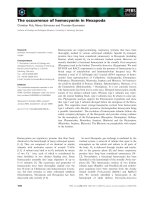
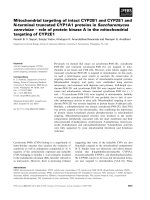
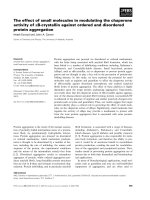
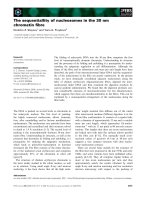
![Tài liệu Báo cáo khoa học: The stereochemistry of benzo[a]pyrene-2¢-deoxyguanosine adducts affects DNA methylation by SssI and HhaI DNA methyltransferases pptx](https://media.store123doc.com/images/document/14/br/gc/medium_Y97X8XlBli.jpg)
